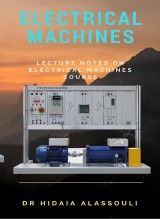Details
Electrical Machines
Lecture Notes for Electrical Machines Course|
10,99 € |
|
| Verlag: | Dr. Hidaia Mahmood Alassouli |
| Format: | EPUB |
| Veröffentl.: | 30.06.2020 |
| ISBN/EAN: | 9783969443439 |
| Sprache: | englisch |
| Anzahl Seiten: | 339 |
Dieses eBook enthält ein Wasserzeichen.
Beschreibungen
This book includes my lecture notes for electrical machines course. The book is divided to different learning partsPart 1- Apply basic physical concepts to explain the operation and solve problems related to electrical machines.Part 2- Explain the principles underlying the performance of three-phase electrical machines.Part 3- Analyse, operate and test three-phase induction machines.Part 4- Investigate the performance, design, operation, and testing of the three-phase synchronous machine.Part1: Apply basic physical concepts to explain the operation and solve problems related to electrical machines.Describe the construction of simple magnetic circuits, both with and without an air gap. Explain the basic laws which govern the electrical machine operation, such as Faraday's Law, Ampere-Biot-Savart's Law, and Lenz's Law. Apply Faraday's Law of electromagnetic induction, Ampere-Biot-Savart's Law, and Lenz's Law to solve for induced voltage and currents in relation to simple magnetic circuits with movable parts. Illustrate the principle of the electromechanical energy conversion in magnetic circuits with movable parts.Part 2: Explain the principles underlying the performance of three-phase electrical machines. Compare and contrast concentric and distributed windings in three-phase electrical machines. Identify the advantages of distributed windings applied to three-phase machines. Explain how the pulsating and rotating magnetic fields are produced in distributed windings. Calculate the synchronous speed of a machine based on its number of poles and frequency of the supply. Describe the process of torque production in multi-phase machines.Part 3: Analyse, operate and test three-phase induction machines. Calculate the slip of an induction machine given the operating and synchronous speeds. Calculate and compare between different torques of a three-phase induction machine, such as the locked rotor or starting torque, pull-up torque, breakdown torque, full-load torque or braking torque. Develop and manipulate the equivalent circuit model for the three-phase induction machine. Analyse, and test experimentally, the torque-speed and current-speed characteristics of induction machines. and discuss the effects of varying such motor parameters as rotor resistance, supply voltage and supply frequency on motor torque-speed characteristics. Perform no-load and blocked rotor tests in order to determine the equivalent circuit parameters of an induction machine. Explore various techniques to start an induction motor. Identify the applications of the three-phase induction machines in industry and utility. Classify the insulations implemented in electrical machines windings and identify the factors affecting them. Part4. Investigate the performance, design, operation, and testing of the three-phase synchronous machine. Describe the construction of three-phase synchronous machines, particularly the rotor, stator windings and the rotor saliency. Develop and manipulate an equivalent circuit model for the three-phase synchronous machine. Sketch the phasor diagram of a non-salient poles synchronous machine operating at various modes operation, such as no-load operation, motor operation, and generator operation. Investigate the influence of the rotor saliency on machine performance. Perform open and short circuit tests in order to determine the equivalent circuit parameters of a synchronous machine. Identify the applications of the three-phase synchronous machines in industry and utility List and explain the conditions of parallel operation of a group of synchronous generators. Evaluate the performance of the synchronous condenser and describe the power flow control between a synchronous condenser and the utility in both modes: over and under excited. Explain the principles of controlling the output voltage and frequency of a synchronous generator.
I am Dr. Hidaia Mahmoud Mohamed Alassouli. I completed my PhD degree in Electrical Engineering from Czech Technical University by February 2003, and my M. Sc. degree in Electrical Engineering from Bahrain University by June 1995. I completed also one study year of most important courses in telecommunication and computer engineering courses in Islamic university in Gaza. So, I covered most important subjects in Electrical Engineering, Computer Engineering and Telecommunications Engineering during my study. My nationality is Palestinian from gaza strip.I obtained a lot of certified courses in MCSE, SPSS, Cisco (CCNA), A+, Linux.I worked as Electrical, Telecommunicating and Computer Engineer in a lot of institutions. I worked also as a computer networking administrator. I had considerable undergraduate teaching experience in several types of courses in many universities. I handled teaching the most important subjects in Electrical and Telecommunication and Computer Engineering. I could publish a lot of papers a top-tier journals and conference proceedings, besides I published a lot of books in Publishing and Distribution houses.I wrote a lot of important Arabic articles on online news websites. I also have my own magazine website that I publish on it all my articles: http:// www.anticorruption.000space.comMy personal website: www.hidaia-alassouli.000space.comEmail: hidaia_alassouli@hotmail.com


















